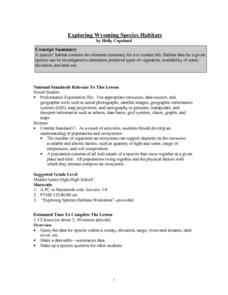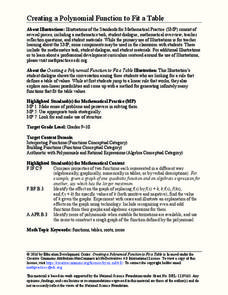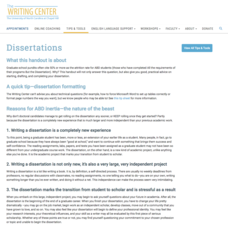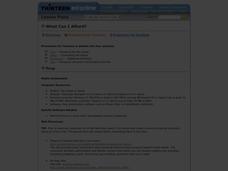Curated OER
Spelling Words for Snow Surprise
In this spelling words for Snow Surprise worksheet, 1st graders read and write 6 high frequency words and 10 spelling words, write the long o words in a story, complete 6 sentences with high frequency words, answer questions about...
Curated OER
Sight Words: blending a
Students use letter cards in order to practice blending consonants with the letter a. In this blending with a worksheet, students practice the word "at" for the a-t sound.
Curated OER
Language in Use and Context
In this language in use and context worksheet, 9th graders read examples of word usage, complete 20 sentences, rewrite 10 sentences in the correct sequence and sort verbs by tense.
Curated OER
Frequency Distributions
In this statistics worksheet, students solve 5 frequency problems. In four of the problems, the frequency table is provided and students construct one relative frequency table, one cumulative frequency table, and two cumulative relative...
Curated OER
Exploring Wyoming Species Habitats
Students are introduced to the concept of species habitats and ranges. They introduced to ArcView GIS as a tool for mapping. Pupils use query data for species withina county, elevation, range, rivers and streams, land cover, and etc....
Curated OER
Concepts Of Division
In a comprehensive and well-outlined series of activities, the class investigates how division is the same as repeated subtraction. During guided practice, they take notes on turning sample word problems into solvable equations and...
Curated OER
How Can You Tell One Clear Gas From Another?
Fifth graders perform experiments to determine the identity of an unknown gas sample. In this chemistry lesson, 5th graders fill balloons with air, oxygen, hydrogen, and carbon dioxide. They use mass and reactivity to identify the gases.
Curated OER
Measures of Center
In this statistics worksheet, students find mean, median, and mode for 3 problems. They find the mean of summarized data in 2 problems.
Curated OER
Is Your Money Rolling Away?
Young scholars demonstrate how to solve word problems. They will watch the video "Math Can Take You Places" and identify three problem solving strategies.
Curated OER
Identify and Graph Linear Equations
Learners investigate linear functions. In this mathematics lesson, students plot points onto a graph by solving the equations y=x and y=mx+b by being given numbers for x and solving for y.
abcteach
A Turkey for Thanksgiving
If you're reading Eve Bunting's A Turkey for Thanksgiving, take a look at these activities to follow the story. Kids complete a crossword puzzle, word search, event sequence activity, and multiple choice reading quiz before responding to...
Education Development Center
Creating a Polynomial Function to Fit a Table
Discover relationships between linear and nonlinear functions. Initially, a set of data seems linear, but upon further exploration, pupils realize the data can model an infinite number of functions. Scholars use multiple representations...
Curated OER
Multiplication Chart-Partially Filled
An excellent practice resource for helping students to master their multiplication skills. With 89 spaces missing from a 10x10 multiplication table, students must work to fill in the blanks and complete their multiplication chart. There...
Towson University
Looking Backwards, Looking Forward
How do scientists know what Earth's climate was like millions of years ago? Young environmental scholars discover how researchers used proxy data to determine the conditions present before written record. Grouped pupils gain experience...
Reading Resource
Flip It Down - Advanced Code Reading Game
A fun twist on bingo helps your kids learn their vowel sounds. As you call out each word, kids flip the tabs on a gameboard to cover their words and be the first to cover them all.
Curated OER
Fuel Cell Experimentation
With rising oil prices and increasing concerns over global warming, the pressure is on for engineers to develop alternative sources of energy. Among the new technologies being developed are hydrogen fuel cells, which young scientists...
Association of American Geographers
Project GeoSTART
Investigate the fascinating, yet terrifying phenomenon of hurricanes from the safety of your classroom using this earth science unit. Focusing on developing young scientists' spacial thinking skills, these lessons engage learners in...
Virginia Department of Education
Heat and Thermal Energy Transfer
How does radiation affect our daily lives? Answer that question and others with a lesson that discusses radiation and its use in thermal energy transfer through electromagnetic waves. Pupils investigate vaporization and evaporation while...
University of North Carolina
Dissertations
Bring on the coffee—it's dissertation time! As a handout on dissertations explains, over 50 percent of PhD candidates never finish their dissertations. The handout, part of a larger series on specific writing styles, helps motivate...
Smarter Balanced
How We Learn
What's the best way to learn the elements of the periodic table? The inventions of Thomas Edison? Patience? To prepare for the performance task assessment on how people learn, class members share ideas about ways to learn in a variety of...
Santa Monica College
Flame Tests of Metal Cations
Scientists used flame tests to identify elements long before the invention of emission spectroscopy. Young chemists observe a flame test of five metal cations in the fourth instructional activity of an 11-part series. Individuals then...
Curated OER
Edit Essays with Word Tables
Students examine how to identify grammar and spelling errors in an essay using the features of Word after the teacher uses the highlight feature. They correct the errors using Word's table feature by making a table that shows the error...
Curated OER
What Can I Afford?
Students explore the concept of cell phone plans. In this cell phone plan instructional activity, students research the cost of cell phones. Students compare various cell phone plans and decide on which phone plan is best for them.
Curated OER
Race and Ethnicity in the United States
Students explore race and ethnicity as it is defined by the U. S. Census Bureau. They compare data from 1900, 1950, and 2000 and identify settlement patterns and changes in population. In groups, they map these changes and discuss...

























